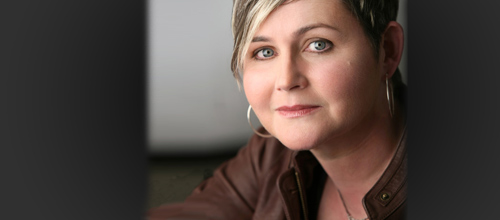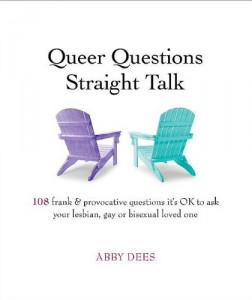Q&A with ‘A Happy Lesbian’
 A chat with author Abby Dees about her inquisitive new book
A chat with author Abby Dees about her inquisitive new book
by Suzie Lynde
Suzie Lynde: What does the Queer Questions Straight Talk book mean to you as the author?
Abby Dees: I’m proud of QQST for exactly what it is: a warm, simple invitation to talk with one another. In the midst of all the political and media rancor about LGBT lives, we sometimes forget how important it is to connect one-on-one with the people we love the most. I forgot this myself at first, so when I began QQST I was somewhat blasé about it. I think it was because I wrote in my natural voice, which came easily. Only when I stepped back a bit did I realize that I had done something I was proud of—specifically because of that authenticity. I want to see all of us doing that in our own way. That’s the whole point of the book.
What’s been the most rewarding aspect of putting this book out there to the public?
I would say that it’s been the response I’ve gotten from LGBT people who get my fundamental message of cutting ourselves and one another a little slack. Our lives are serious, to be sure, but we all seem to recognize how important it is to bring some humor and kindness into our conversations with straight loved ones. There is such a capacity for joy in our community, and that idea in QQST seems to resonate. I see this especially when I’ve talked with LGBT teens who are on the front lines of the fight—they are determined to feel proud and joyful, even if they feel all alone much of the time.
 Your mother edited the book. What was that like?
Your mother edited the book. What was that like?
Well . . . the sex chapter was a little weird to write! So that helped me create a book you could give to your parents without squirming too much. More importantly, this was the coming-full-circle of a 25-year conversation she and I have been having. She was a typical mom when I came out—she meant well, but didn’t have a clue what to ask me. We got to have a lot of amazing conversations and really evaluate how far we’d come together as we talked about every word in the book. It was lovely and I’m proud of her.
Do you consider yourself a role model?
Hmmm. Only in as much as I am an example of what a happy lesbian looks like. I’ve been out for a long time now, and I’ve got a platform through my writing and speaking about this stuff. But there’s nothing unique about me other than I’m a somewhat public example of what anyone can experience if they are patient with themselves and stay hopeful. I know how isolating the closet can be, and I’ve experienced great loss and that sense that I will always be alone because I’m gay. I can also stand up and say out loud that the struggle is so amazingly worth it.
What was the most challenging part of writing Queer Questions Straight Talk?
As I mentioned, the book came surprisingly easily because it was a natural extension of the way I think. The hard part was wondering if anyone else felt the same way. There was a leap of faith involved between writing QQST and handing it to the public. The other hard part was having to put down some of the more painful questions, such as “Are you afraid you’re going to hell?” or “Don’t your rights trample on my rights?” It’s tempting to avoid these questions because we know they are so often steeped in fear and sadness. But people still genuinely don’t know the answers, so we have to be willing to talk about these things and grant people a little grace as they try to understand.
How did you come up with these questions?
I put out the call to everyone I knew via Facebook and e-mail, etc., and asked people to tell me any questions they’d heard, had, or ever wished someone would ask. I invited people to pass the request on to anyone they knew, and so on, and I interviewed a few “experts” who work with LGBT people to make sure I wasn’t missing anything. Finally, I asked for any answers that people had, which I included in the book here and there to show that there are no official right answers to any of these questions. I changed some wording and created composites, but most of the responses made it into the book.
I actually chose the number 108 before I had any questions in the hopper. I was a little worried that I’d have to put in some filler material to hit the target. As it happened, I wound up pruning quite a bit to fit all the important stuff in. There’s a lot of curiosity out there, which is just fine as long as it comes from a place of respect and kindness. That is QQST in a nutshell.
Suzie Lynde is a frequent contributor to OutSmart magazine.











Comments